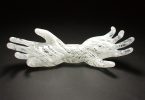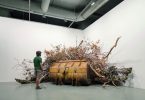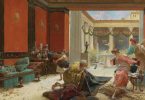The street is crowded every hour of the day. Today, it is more lively than usual; with people flooding it from both sides and a big crowd yelling out slogans and holding banners in their hands. The voices of rights, justice, equality and freedom are ascending to the skies like balloons and God knows on which roof of the city it will burst and blossom. Shall we take this as a sign? Is this a beautiful sign just before my visit to the ‘Anatolian Weights and Measures Exhibition’ held at the Pera Museum? As measures and scales are the results of man´s search for rights, justice and equality, then I ought to take a look at the displays with this perspective! Otherwise, why does man ever weigh and measure?
According to one opinion, civilisations do not begin with agricultural production but instead with trade. The principle of equality between what is bought and given in return is initially established with the scale of the eyes. In one of his movies, director Jean Luc Godard says, ¨people created money in order to eliminate eye contact¨. At the end of the day, measures and scales are all means to money and value. Furthermore, it is crucial in our lives. While visiting the collection of Suna and Inan Kıraç, it is impossible to ignore the symbolic stories of the weights used throughout Egypt, Palestine, Mesopotamia and mostly Anatolia. It is also a great opportunity to observe the symbols of weights and measures belonging to the Romans, Byzantines and Ottomans. As well as the scales used to measure goods in solid, liquid, gold and silver, one will also come across the instruments used in architecture and engineering. Since the year 2000 BC up until today, one ought to take a look at the weights and measures used in Anatolia both with the eye as well as with a delicate observation. And that is exactly what I have done. Firstly, my heart was captivated by a scale with flower motifs. I almost ripped my heart out of my chest, so it could weigh it! I do not know how much it weighed. God knows what kind of masterful hands engraved it. I wonder which hidden love is behind those rose patterns? Or perhaps they were used to buy and sell roses. I wonder if they meant to say that scaling and measuring is all about elegance? You just cannot get enough of watching this mechanism that stands before you like a state of the art work. And what about that delicate scales coffer? It is just like a disciple submitted to time with its red colour, adorned with motifs and all its scales and weights. Weights lined up side by side. With the Byzantines and Romans wrapped in different atmospheres. Some shaped like an empress effigy and some like an Athena effigy. While, one ought to study the weighing machines with its animal shaped points in more detail going until the edge of the abstract.
And Anatolia! All of the different shapes of weights are spread out regionally beginning with the Aegean down to the Mediterranean. Both the weights and stones of amphoras. You will come across the weights shaped like a sleeping duck, or even those shaped like frog and bull heads. Anatolia was not only a region of labourers; throughout ages it always inserted art within its labours. It is for this reason that one ought to look at these devices and shapes as works of art instead of objects. The luckiest actors of these long periods were the hands measuring wheat and milk, and the jewellery makers and architects. They were the indicators of the changes within social life: the metric system, dirhams, grams, Turkish yard and metres are not only words – they are the evidences of the change in mentality.
Weighbridges that have almost been completely wiped out of our daily lives… Its knobs, hooks and chains full of traces of fantasies. Imagine all of the liver, fruits and heavy weights it was used for.
Its fineness of design and, if need be, its use is still possible today. It is for this reason that these objects are immortal and impassable in comparison to the electronic and digital world of today. In a way, they are like the classics of art. They were the remedies that were measured gram by gram in pharmacies! And the double scales… The scale that is used as the symbol of justice throughout many countries in the world today. From the most primitive to the most abstract… They voice the search for rights, justice and law. The metres and Turkish yards (archine)… With all its bazaar archine, metres, ells, bushels, grain scales, cases, volume measures, and all wooden and iron measures to weigh wheat and barley. And the first attempt at a computer, ¨The Rubu Board¨. Isn´t time just like matter measurable anyway…
We must remember the architects and the amateur masters who had thought and designed these devices. We must also remember the t square, compass and the overhead scale that is considered to be the right hand of architects. One ought to stand before all of them and salute them and remember the critical role each of them played within the establishment of the civilisations. We ought to trace the steps of the scale used by master architects like Sinan for the greatest structures like aqueducts. In fact, an exhibition, all of the objects on display, the works of art, its spirit and its traces can also be found outside. They have siblings, lost siblings.
A day shall come when the devices used today will also become an object on display in a museum. Cellphones that count the number of steps we take per day, digital scales that weigh dust, thermometres and barcode machinery will all weigh the past one day. However, the truth is that each of them will become similar to one another, lacking details of art, useless for weighing roses, and deprived of intricate engravings and love. However, man´s voice for rights, justice, equality shall never come to an end. Furthermore, the eye, which is the scale that delves deep inside one another, shall never be lost. Even if we become blind, the inner eye will forever exist within us.









Leave a Comment